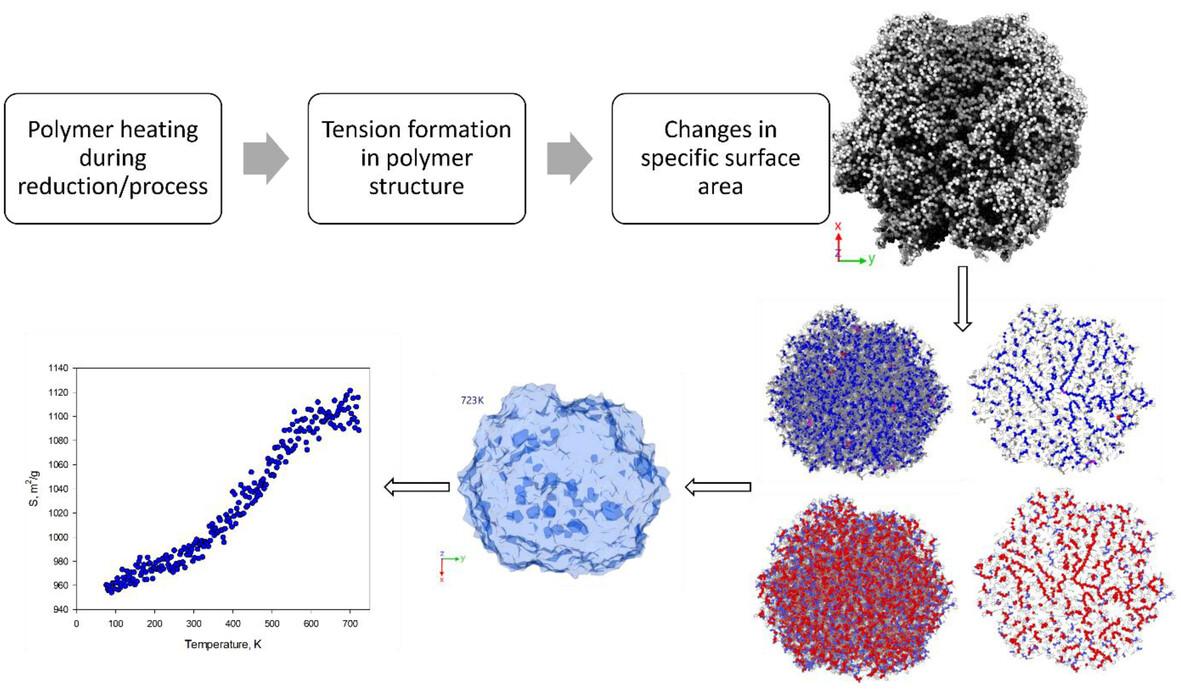求助PDF
{"title":"Temperature effect on tension formation in styrene–divinylbenzene copolymers","authors":"Alexey V Bykov, Galina N Demidenko, Antonina A Stepacheva, Mariia E Markova","doi":"10.1002/pi.6669","DOIUrl":null,"url":null,"abstract":"<p>Crosslinked polymers are considered to be promising materials for supporting catalysts that are effectively applied in different reactions. However, the application of polymer-supported catalysts in high-temperature processes is limited by their temperature stability. Besides thermal degradation, temperature changes can cause the restructuring of the polymer network because of changes in the valence angles and bond lengths. Thus, the study of the influence of temperature on the structure of crosslinked styrene–divinylbenzene (StDVB) copolymers is an important task. In this work, for the first time, the temperature effect limitations on StDVB copolymers are studied and justified. The changes in the polymer structure tension as well as in the specific surface area are studied using molecular dynamics simulation in the temperature range 77–723 K. Near-cryogenic temperatures are not found to affect significantly the specific surface area. The heating of the polymer up to the temperature used for the reduction of catalysts (573 K) is shown to decrease the specific surface area by 11% because of an increase in the bond tension and valence angle deformation. Further increase in temperature leads to polymer decomposition. The results obtained can be considered for taking into account when applying polymer-supported catalysts. © 2024 Society of Chemical Industry.</p>","PeriodicalId":20404,"journal":{"name":"Polymer International","volume":"73 10","pages":"852-863"},"PeriodicalIF":3.6000,"publicationDate":"2024-06-07","publicationTypes":"Journal Article","fieldsOfStudy":null,"isOpenAccess":false,"openAccessPdf":"","citationCount":"0","resultStr":null,"platform":"Semanticscholar","paperid":null,"PeriodicalName":"Polymer International","FirstCategoryId":"92","ListUrlMain":"https://onlinelibrary.wiley.com/doi/10.1002/pi.6669","RegionNum":4,"RegionCategory":"化学","ArticlePicture":[],"TitleCN":null,"AbstractTextCN":null,"PMCID":null,"EPubDate":"","PubModel":"","JCR":"Q2","JCRName":"POLYMER SCIENCE","Score":null,"Total":0}
引用次数: 0
引用
批量引用
Abstract
Crosslinked polymers are considered to be promising materials for supporting catalysts that are effectively applied in different reactions. However, the application of polymer-supported catalysts in high-temperature processes is limited by their temperature stability. Besides thermal degradation, temperature changes can cause the restructuring of the polymer network because of changes in the valence angles and bond lengths. Thus, the study of the influence of temperature on the structure of crosslinked styrene–divinylbenzene (StDVB) copolymers is an important task. In this work, for the first time, the temperature effect limitations on StDVB copolymers are studied and justified. The changes in the polymer structure tension as well as in the specific surface area are studied using molecular dynamics simulation in the temperature range 77–723 K. Near-cryogenic temperatures are not found to affect significantly the specific surface area. The heating of the polymer up to the temperature used for the reduction of catalysts (573 K) is shown to decrease the specific surface area by 11% because of an increase in the bond tension and valence angle deformation. Further increase in temperature leads to polymer decomposition. The results obtained can be considered for taking into account when applying polymer-supported catalysts. © 2024 Society of Chemical Industry.
温度对苯乙烯-二乙烯基苯共聚物张力形成的影响
交联聚合物被认为是很有前途的催化剂支撑材料,可有效地应用于不同的反应。然而,聚合物支撑催化剂在高温工艺中的应用受到其温度稳定性的限制。除了热降解外,温度变化还可能导致聚合物网络重组,因为价角和键长发生了变化。因此,研究温度对交联苯乙烯-二乙烯基苯(StDVB)共聚物结构的影响是一项重要任务。本研究首次对 StDVB 共聚物的温度效应限制进行了研究和论证。利用分子动力学模拟研究了 77-723 K 温度范围内聚合物结构张力和比表面积的变化。将聚合物加热到用于还原催化剂的温度(573 K)时,由于键张力和价角变形的增加,比表面积减少了 11%。温度进一步升高会导致聚合物分解。在应用聚合物支撑催化剂时,可将所获得的结果考虑在内。© 2024 化学工业协会。
本文章由计算机程序翻译,如有差异,请以英文原文为准。


 求助内容:
求助内容: 应助结果提醒方式:
应助结果提醒方式:


